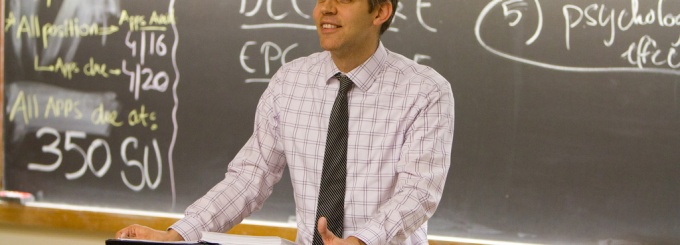Steilen’s history-of-law paper selected for leading conference

A new look at the case of an 18th century terrorist in Virginia has brought recognition to a SUNY Buffalo Law faculty member.
Associate Professor Matthew Steilen’s paper, “The Josiah Philips Attainder and the Institutional Structure of the American Revolution,” was selected for the 2016 Law & Humanities Interdisciplinary Junior Scholar Workshop. This year, seven papers were selected from what organizers describe as “a very large pool of submissions.” Steilen was the only legal scholar whose work was chosen.
The papers will be presented and discussed June 6-7 at the UCLA School of Law. Steilen’s paper will also be published in an upcoming issue of the journal Critical Analysis of Law.
Steilen’s research interests center around the history and development of the separation of powers. He says the case of Josiah Philips is a well-known one, set in the years immediately following the Declaration of Independence.
Philips, a Loyalist in the midst of the American Revolution, led a criminal gang that terrorized Virginians in two counties. A contemporary account called them “a party of desperadoes” who had “commenced to rob and murder … peaceful citizens.”
Efforts to apprehend them failed; for one thing, Virginia’s leaders had a lot on their minds. “These militant, criminal loyalists posed a serious challenge for the new state governments formed in 1776 and 1777,” Steilen writes. “States like New York, Pennsylvania and Virginia struggled to administer civil justice and protect citizens across their expansive territories, and in some cases militants were able to operate in essentially ungoverned areas.”
So Virginia turned to Thomas Jefferson, a leading member of the colony’s House of Delegates, who drafted a bill of attainder – essentially a legislative ‘indictment’ ordering Philips to surrender and face trial. It accused him of treason, arguing, Steilen writes, that “widespread murder, arson and robbery, accompanied by armed resistance, constituted levying war against the commonwealth.”
Philips was given a month to surrender, but was captured before the deadline passed. He was tried and convicted – not for treason, but for robbery that netted him merely “28 men’s felt hats … and 5 pounds of twine.” All manner of felonies were considered capital offenses in that era, and in December 1778, Philips was hanged.
Steilen is interested in how legislators used the bill of attainder as a law enforcement tool during wartime. “Instead of prosecuting the Philips gang for treason, which was difficult under the relevant English law, colonial authorities pursued them on the basis of felony charges, because the punishment was the same. They didn’t have to meet the procedural requirements,” he says.
“If your state is being invaded by the British army and much of it is not under your control, if you can’t enforce the law by calling out the militia, how do you deal with people who are terrorizing civilians? The bill of attainder was one mechanism for doing this. By passing such a bill, the legislature itself acted like a court and sheriff, exercising judicial and executive power.”
Steilen’s conclusions are based on a study of primary sources, including letters and personal histories written by Jefferson, Patrick Henry and other Virginia revolutionary leaders. SUNY Buffalo law library holds much of these materials, and other texts were available through the Library of Congress and online repositories.
He plans to build on this paper for a book-length project on attainder and the separation of power during wartime: “It’s an interesting way to study the ways in which people engaged in armed conflict thought about how to provide justice in the course of the conflict – when ordinary forms of civil justice in a court of law applied and when they had to resort to other forms of proceedings. It is a problem we still face today.”